Watercolor Painting for Beginners: Workbooks & Supplies
Dive into Watercolor: Beginner-Friendly Workbooks and Essential Supplies 🎨
Watercolor painting can be a wonderfully relaxing and rewarding hobby. But starting out can feel intimidating! Luckily, there are resources designed to help even the most novice artist create beautiful watercolor masterpieces. This article will explore beginner-friendly watercolor workbooks and other essential supplies to get you started on your artistic journey.
H2: Understanding Beginner-Friendly Watercolor Workbooks
Watercolor workbooks designed for beginners are structured to guide you through the fundamentals. They often include step-by-step instructions, pre-printed outlines, and practice exercises to help you develop your skills and confidence.
H3: What Makes a Workbook “Beginner-Friendly”?
A beginner-friendly watercolor workbook will typically feature these elements:
- Clear Instructions: Easy-to-understand directions with helpful diagrams and illustrations. No art jargon that will confuse you! 📝
- Basic Techniques: Focused lessons on core watercolor techniques like washes, layering, blending, and lifting color. 🖌️
- Practice Exercises: Guided exercises to practice each technique before moving on to more complex projects.
- Pre-printed Outlines: Lightly printed outlines to help you focus on color mixing and brush control, rather than drawing. Some workbooks, like the Ugalqan Watercolor Workbook, specifically offer this feature.
- Specific Projects: Small, achievable projects to build confidence and showcase your new skills. 🖼️
- High-Quality Paper: Good quality paper is crucial! Workbooks designed for watercolor usually use thicker paper stock (140 lb or 300 gsm) to prevent buckling and bleeding.
H3: Key Benefits of Using a Workbook
Using a watercolor workbook offers several advantages for beginners:
- Structured Learning: A workbook provides a structured path to learning watercolor, helping you avoid feeling overwhelmed.
- Reduced Stress: Pre-printed outlines and clear instructions reduce the stress of starting from scratch.
- Confidence Building: Completing the exercises and projects boosts your confidence and encourages you to continue learning.
- Convenience: All the information and guidance you need is contained in one place.
H2: Essential Watercolor Supplies for Beginners
While a workbook is a great starting point, you’ll also need a few essential supplies to get painting.
H3: Watercolor Paints
- Pans vs. Tubes: Both pan and tube watercolors are suitable for beginners. Pan sets are more portable and easier to clean, while tubes offer more control over color mixing. Start with a basic set of 12-24 colors. 🌈
- Student Grade vs. Artist Grade: Student-grade paints are more affordable and perfectly acceptable for learning. Artist-grade paints have higher pigment concentrations and offer richer, more vibrant colors, but are more expensive.
H3: Watercolor Brushes
- Round Brushes: Essential for detail work, fine lines, and creating varied strokes.
- Flat Brushes: Ideal for washes, covering large areas, and creating sharp edges.
- Synthetic vs. Natural Hair: Synthetic brushes are more affordable, durable, and easier to clean, making them a good choice for beginners.
- Variety of Sizes: A small selection of brush sizes (e.g., round sizes 2, 6, and 10, and a 1-inch flat brush) will allow you to tackle a variety of projects.
H3: Watercolor Paper
- Weight: Look for paper that is at least 140 lb (300 gsm) to prevent buckling and warping.
- Surface: Cold press paper has a slightly textured surface that’s ideal for watercolor painting. Hot press paper is smoother and better suited for detailed work. Rough paper has a very textured surface and can create interesting effects.
- Format: Paper comes in blocks, pads, and sheets. Blocks are glued on all four sides, preventing the paper from buckling.
H3: Other Helpful Supplies
- Palette: A palette for mixing your paints. A ceramic plate or a plastic palette with wells works well.
- Water Container: Two containers of water: one for cleaning your brushes and one for diluting your paints.
- Paper Towels or a Soft Cloth: For blotting brushes and cleaning up spills.
- Masking Tape: To secure your paper to a board or table.
- Pencil and Eraser: For sketching outlines (if not using a pre-printed workbook).
- Spray Bottle: To keep your paints moist.
H2: Getting Started with Your Watercolor Journey
With a beginner-friendly workbook and the right supplies, you’re ready to begin your watercolor adventure! Don’t be afraid to experiment, make mistakes, and most importantly, have fun! Happy painting! 🎉





Post Comment